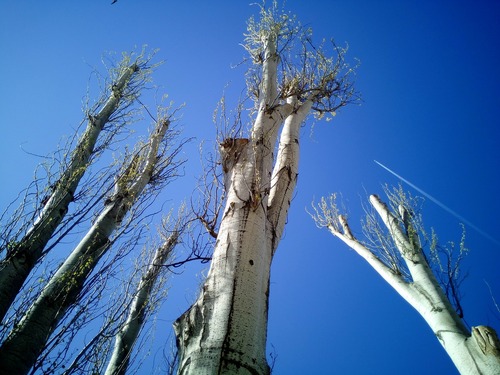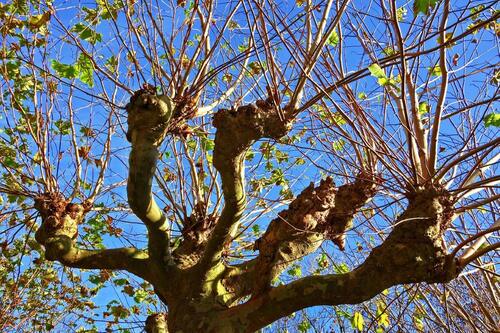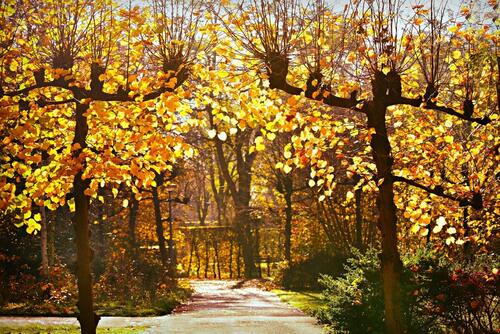Topping Trees: Controversial Yet Common Practice
Tree Topping Versus Pollarding: The Debate on Controlling Urban Tree Growth
Tree topping, the indiscriminate cutting back of tree branches to stubs, is a controversial practice in urban forestry management . While some view it as a quick and affordable way to control tree size, most arborists condemn topping as extremely harmful to tree health. This article will examine the debate around topping, contrast it with more sustainable practices like pollarding, and explore how citizens can promote urban forest conservation.
Hazards of Indiscriminate Tree Topping in Cities

Tree Topping in Progress
Tree topping has been practiced in urban areas for decades as a quick and seemingly inexpensive way to control tree size. However, this technique, involving the indiscriminate cutting back of mature tree branches to stubs, has become increasingly controversial among professional arborists and urban foresters.
Proponents’ Arguments
Proponents of topping argue it is a pragmatic necessity to constrain large trees in dense urban areas . Without intervention, tree canopies can easily come to interfere with infrastructure like power lines. Topping appears to offer an affordable and straightforward solution. However, its structural imprecision fails to account for the complex physiology of mature trees.
Negative Consequences of Topping

Watersprouts Forming on Topped Trees – Photo by PortalJardin on Pixabay
By abruptly removing major limbs without regard for location or remaining connections, topping puts undue stress on the vascular system used to transport water and nutrients to the leaves. It essentially forces the tree to suddenly divert resources to a limited number of new watersprouts, which emerge weakly attached. This leaves the tree vulnerable to sun damage, insect infestation, and decay—essentially permanently compromising its structural integrity.
This precipitates a perpetual cycle of decline. The watersprouts and epicormic shoots that emerge following topping grow exponentially faster than normal. However, they remain fragilely attached. This leads to recurrent decay or snap off, posing public safety threats from falling branches. Over time, the struggling tree essentially becomes a liability, creating costly management problems and requiring premature removal. This completely undermines the perceived savings initially promised by topping.
Legal and Ethical Considerations
For these reasons, topping violates a number of standards prescribed by arboriculture authorities. Many municipal governments have chosen to preemptively ban the practice by law. However, proponents believe that in areas with dense populations and soaring property values, more extreme containment solutions are sometimes necessary to preserve aging trees. Ongoing debate continues around finding an ethical balance.
Sustainable alternatives like crown reduction pruning promote structured growth while retaining the tree’s natural form. Though more expensive up front, this approach supports longevity and requires less maintenance over time. Likewise pollarding trees from a young age shapes growth in a consistent fashion.
There is no end-all, be-all answer. However, through responsible planting selections and offering greater space for root and canopy development, urban centers can overcome many conflicts blamed on overgrown trees. Communities committed to harvesting the biological services conferred by healthy, resilient forests must prioritize strategic nurturing over reactive extremes. The stakes for our environmental and community well-being are simply too high.
Beyond the damage it inflicts on individual specimens, topping undermines the wider benefits conferred by healthy urban forests, like improved air quality, wildlife habitat, aesthetics, and quality of life. As such, the practice is widely condemned by professional arboricultural associations. Additionally, m unicipalities have made topping illegal due to its harmful effects.
Outlawing Topping as Inimical Practice
Due to the devastating impacts of indiscriminate topping on tree health and urban forests, many jurisdictions have made the practice explicitly illegal. The City of San Francisco outlawed topping way back in 1977—one of the first cities to do so based on evidence from arborists. The policy renders topping a citable offense subject to fines for property owners.
Countries like Australia and cities across the USA and Canada have followed suit with similar prohibitions as professional consensus continues to view topping as an inherently inimical “non-practice.” Enforcement remains challenging, however, as the shorter-term imagined cost and time savings still compel unauthorized property owners to resort to topping. But its illegality reinforces strong ethics-based opposition to topping amidst sustainable arboriculture standards.
Outreach and education are still needed to inform community understanding of best practices for nurturing resilient urban forests.
Pollarding

A Pollarded Willow Tree – Photo by Mabel Amber from Pixabay
In contrast, pollarding is the careful removal of upper branches on specific tree species to achieve practical goals like generating wood or keeping growth within confined spaces near buildings or utilities. Though still controversial itself, controlled pollarding is preferable to indiscriminate topping because, when properly practiced, it can effectively shape trees without sacrificing their structural integrity.
The Legend Behind the Pollarding Tradition
While not conclusively verified, some retellings attribute the origins of ornamental pollarding to a legend involving King Louis XIV in 17th-century France. As lore goes, faced with a shortage of firewood, Louis banned the chopping down of any tree thicker than his thumb. In response, ingenious peasants began pollarding—cutting back upper branches to encourage regrowth while still yielding thumb-sized wood. Though unconfirmed, this speaks to pollarding’s birth from necessity and human creativity. True or embellished, the tale endures as part of cultural heritage—not unlike pollarding itself, despite modern questions of validity. Much as we admire the resplendent uniform avenues of pollarded London planes today along Parisian boulevards like the iconic Champs-Élysées, perhaps their sculpting pays homage to apocryphal yet persistent notions of innovation born from scarcity. Sometimes the substance of tradition lies less in obscure factual details than in the persistent inspiration of the narrative.
Sustainable Pollarding Practices Through History
Pollarding must be enacted on young saplings to be effective; mature tree growth cannot be as easily manipulated. When performed correctly, including follow-up pruning, pollarding allows for healthy regeneration of new wood while extending the productive life of the tree. Urban forest managers in dense city spaces struggling to balance preservation with functionality may therefore justifiably utilize pollarding to avoid more destructive solutions.
Pollarding involves the removal of the upper branches and leaders of trees at intervals of 1-3 years. Unlike topping, where mature branches are indiscriminately cut back to stubs, pollarding relies on the strategic removal of younger growth. Though still controversial itself, controlled pollarding is generally considered more sustainable than topping.
The key distinction lies in pollarding’s alignment with the natural physiological processes of trees. When performed correctly on suitable species at regular intervals starting at an early age, it stimulates the growth of multiple lateral branches while maintaining apical dominance. This allows trees to continue producing foliage critical for photosynthesis while redirecting growth to secondary shoots, which can be sustainably harvested as a renewable source of wood.
Follow-through
Pollarding does require consistent follow-up pruning to maintain the desired form. When executed improperly, it can leave trees starved of leaves or vulnerable to sun damage. Additionally, this dramatic pruning can create points of entry for decay fungi. However, the reductions in height and width conferred by pollarding make it an attractive technique for historically significant trees or those confined by urban infrastructure.
The time commitment and specialized knowledge involved mean pollarding is less viable for private homeowners looking to simply reduce tree size. However, for municipalities and historic sites seeking to implement sustainable urban forest management across tree populations, it remains a justifiable technique. Though sometimes seen as antiquated, pollarding’s continued use for functional purposes illustrates the merits underlying this age-old practice—when applied conscientiously.
Urban foresters must weigh pollarding’s utility in particular contexts against less intensive alternatives like crown reduction or winnowing out overextended branches. But for scenarios requiring more dramatic containment, pollarding executed skillfully by professionals provides a reliable approach to directing tree growth while supporting their persisting health.
Cultural Motivations Behind Pollarding’s Continued Use

Pollarded Trees with Autumn Foliage – Image by Mabel Amber from Pixabay
Some critics argue pollarding represents an antiquated approach with questionable benefits in modern arboriculture. However, the technique persists internationally due to both functional utility and cultural motivations. In cramped urban European city centers, pollarding remains an important tool for tree size control. Additionally, certain heritage gardens and historically protected sites continue pollarding traditions to preserve a beloved landscape aesthetic. Though the dramatic annual pruning involved may seem questionable, this points to deeper motivations.
The fact that pollarding requires specialized knowledge and continuous commitment means it endures largely by choice—not convenience. For aging city trees already confined by infrastructure, transitioning to less intensive pruning could further compromise their health. Thus, for urban forest managers dealing with unique local challenges, pollarding remains a best practice—not an outdated solution. For cultural heritage sites seeking to conserve a symbolic, idyllic ambience, the visual uniformity achieved through cyclical pollarding is irreplaceable. Though we must continually reevaluate its applications based on emerging tree research, pollarding’s persistence attests to its abiding utility for certain controlled contexts.
Strategies for Healthy Urban Forest Conservation

San Francisco’s Iconic Urban Trees – Photo by Piotr Musioł on Unsplash
Citizens can promote sustainable urban forest management by first avoiding topping privately owned trees and understanding proper modern arboricultural practices instead. Community education campaigns, volunteer planting/pruning initiatives, and getting involved in municipal decision-making can also nurture a shared sense of responsibility around urban tree stewardship.
On a wider scale, residents can contribute by reducing their environmental footprint through public transit usage, local food sourcing, proper waste management, and limiting pesticide/herbicide applications that may impact adjacent trees. Building connections with nature where we live and recognizing the tangible benefits healthy community forests impart lie at the heart of sustainability.
Though practices like topping may seem to offer simple, short-term solutions, as our understanding of urban forest ecology continues to grow, we must prioritize strategic nurturing of resilient arboreal havens for future generations. It is incumbent on each of us to adjust behaviors and mindsets to advance this worthy and urgent cause.
Arborist Now’s Best Practices for Ethical and Sustainable Care
At Arborist Now, we stay dedicated to researching and advancing best practices reflecting our ever-growing understanding of urban forest ecology. We continue working locally and with municipalities to nurture resilience through biodiversity, community education, and appropriate tree selection for future plantings. Our teams employ only ethical techniques centered on long-term tree health—never antiquated extremes like topping. Through our advocacy and actions, we hope more residents feel empowered to make sustainable choices benefiting urban canopies for generations.
The future remains rooted in knowledge, cooperation, and embracing our shared responsibility as temporary stewards of the living arboreal treasures enriching our communities. We welcome community members to get in touch with any questions and suggestions furthering this important discussion on urban forestry. Let’s continue to nurture resilient trees benefiting all.


